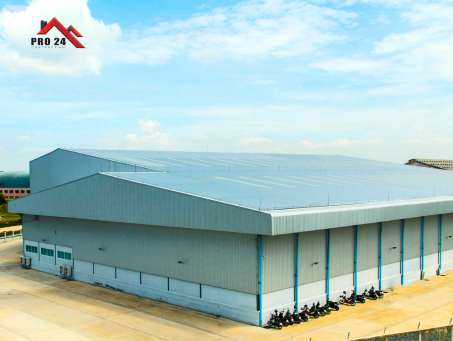Severe storms can wreak havoc on commercial properties, with roofs often taking the brunt of the damage. A compromised roof can lead to significant issues, from water infiltration to structural damage, jeopardizing both your building and business operations. Knowing how to respond quickly and effectively after a storm is essential for minimizing losses and ensuring a safe environment.
This guide will walk you through the critical steps to take after severe weather, from securing your property to assessing the damage and contacting professional contractors for commercial roof repair. Acting swiftly can make all the difference in protecting your investment and restoring normalcy.
1. Immediate Steps to Secure the Building
After a storm, your first priority is the safety of people and property. Acting swiftly and efficiently to secure your building can prevent further damage and ensure a safe environment. Follow these expanded steps:
- Ensure Safety
- Inspect from a Safe Distance. Conduct an initial inspection from the ground to identify obvious hazards, such as fallen power lines, debris, or visible roof damage. Do not enter damaged areas until they have been deemed safe.
- Address Immediate Hazards. Notify utility companies if you notice downed power lines or exposed electrical systems. Block off unsafe zones to prevent accidental entry by employees or customers.
- Prioritize Safety Equipment. If accessing the interior, wear protective gear like helmets and boots to guard against falling debris or slippery surfaces.
- Protect Against Further Damage
- Cover Exposed Areas. Use tarps or heavy-duty plastic sheeting to temporarily cover damaged sections of the roof. Secure them tightly to prevent wind from displacing them.
- Mitigate Water Entry. Place buckets or containers under interior leaks to catch water and prevent it from spreading to other areas.
- Clear Blockages. Remove debris from gutters, downspouts, and drainage systems to allow proper water flow and reduce pooling on the roof.
- Secure Loose Items. If the storm has displaced rooftop equipment like HVAC units or vents, secure them to prevent additional structural stress.
- Document the Damage
- Capture Detailed Evidence. Take high-resolution photos and videos of all affected areas, both inside and outside the building. Focus on damaged roofing materials, water stains, and compromised equipment.
- Maintain a Log. Create a timeline of events, noting when the storm occurred, the type of damage observed, and the steps taken to secure the building. Include receipts for emergency supplies used, such as tarps or tools.
- Establish Communication
- Notify Key Personnel. Inform building managers, tenants, or employees about the damage and any restrictions on access.
- Contact Emergency Service.: If the damage poses an immediate threat to safety, notify local emergency responders or disaster relief services.
2. Assessing Roof Damage After a Storm
Conducting a thorough damage assessment is crucial for understanding the extent of the impact and planning the next steps. A complete evaluation will help prioritize repairs and ensure nothing is overlooked. Follow these detailed guidelines:
- Exterior Inspection
- Roofing Material Damage. Look for missing, cracked, or damaged materials such as shingles, tiles, or panels. Inspect the edges of the roof for curling or broken components that may indicate wind-related damage.
- Structural Indicators. Identify sagging areas, dips, or sections that appear warped. These signs often indicate weakened structural integrity beneath the roofing material. Additionally, check for water pooling on flat roofs, which may suggest compromised drainage systems.
- Accessory Damage. Examine vents, chimneys, skylights, and HVAC units for visible damage. Bent or dislodged components can lead to water infiltration if not promptly addressed.
- Debris Accumulation. Note any tree limbs, branches, or other debris that could have caused punctures or scratches on the roof surface.
- Interior Inspection
- Ceilings and Walls. Look for water stains, peeling paint, or bubbling wallpaper. These are often the first indicators of roof leaks and can point to specific areas needing attention.
- Hidden Moisture. Use a moisture meter to detect damp areas in insulation, drywall, or other porous materials that may not show visible damage. Prolonged moisture can lead to mold growth and compromise air quality.
- Operational Systems. Inspect equipment located near roof penetrations, such as HVAC units or electrical wiring, for signs of water exposure or damage. Corroded components could pose long-term risks to building operations.
- Call in Professionals
- Expert Inspection. Avoid walking on the roof yourself, as storm-damaged areas may be unstable. Contact a professional roofing contractor like Pro 24 contracting for a detailed inspection.
- Comprehensive Report. Professionals can provide an in-depth assessment of visible and hidden damage, ensuring no critical issues are overlooked. Their expertise helps identify repair priorities and potential long-term solutions.
- Estimate Potential Costs
- Repair vs. Replacement. Determine whether the damage warrants repairs or a full replacement. Professionals can provide detailed estimates and help you weigh cost-effectiveness against long-term durability.
- Assess Building Safety
- Evaluate whether areas of the building are safe to occupy. Significant structural damage may require temporary closure until repairs are completed.
3. Working with Your Insurance Company
Navigating the insurance claims process can be overwhelming, especially during an emergency. Here’s how to streamline the process:
- Review Your Policy
- Understand Coverage Details. Familiarize yourself with what your commercial property insurance policy covers, including exclusions and deductible amounts. Many policies include storm-related damage, but coverage for specific repairs or replacements may vary.
- Policy Endorsements. Check if your policy includes endorsements for business interruption or equipment damage, which could offset additional losses incurred during repairs.
- File a Claim Promptly
- Initiate Contact. Notify your insurance company immediately after assessing the damage. Provide them with preliminary documentation, such as photos, videos, and logs of the damage.
- Provide Detailed Descriptions. Clearly outline the extent of the damage and any temporary measures taken to mitigate further harm.
- Follow Up Regularly. Keep in touch with your insurance adjuster to ensure the timely processing of your claim and address any additional documentation requests.
- Coordinate with Your Roofing Contractor
- Collaborative Documentation. Share your contractor’s inspection report with your insurance company. Contractors like Pro 24 are experienced in providing the necessary technical details to support your claim.
- Advocacy. Your contractor can act as your advocate, ensuring that the insurance adjuster fully accounts for all damage and repair requirements.
- Prepare for Adjuster Visits
- Be present during the adjuster’s visit, if possible, and have your contractor available to address technical questions. This collaboration ensures a thorough and accurate evaluation of damages.
4. Emergency Commercial Roof Repair: What to Expect
Once you’ve secured the property and contacted your insurance company, it’s time to focus on repairs. Here’s what the process typically involves:
- Temporary Repairs
In the immediate aftermath of a storm, temporary fixes may be necessary to prevent further damage. This includes tarping over exposed areas and reinforcing weak spots.
- Detailed Assessment
Professional contractors will perform a comprehensive inspection to determine the full extent of the damage and identify necessary repairs.
- Repair Plan and Timeline
Your contractor will provide a detailed repair plan, including cost estimates and a timeline for completion. At Pro 24, we prioritize clear communication and efficiency to minimize disruptions to your business.
- Permanent Repairs
Depending on the damage, repairs may involve replacing roofing materials, fixing structural issues, and restoring waterproofing systems.
In severe cases, a full roof replacement may be recommended for long-term durability.
5. Preventing Future Damage
While you can’t control the weather, proactive measures can reduce the risk of storm damage and ensure your roof is better prepared for future events:
- Regular Inspections and Maintenance
- Schedule routine roof inspections to identify and address minor issues before they become major problems.
- Clear gutters, downspouts, and roof drains of debris to prevent water buildup that can strain the roofing system and lead to leaks.
- Upgrade Roofing Materials
- Invest in weather-resistant materials such as impact-resistant shingles, reinforced membranes, or metal roofing. These options are designed to withstand severe conditions, reducing the likelihood of storm-related damage.
- Consider installing a reflective roof coating to protect the roof from UV damage and improve energy efficiency.
- Install Additional Safeguards
- Reinforce Key Areas: Add extra flashing or sealant around vulnerable areas like vents, chimneys, and skylights to minimize water infiltration risks.
- Structural Enhancements: Install hurricane straps or roof anchors to improve overall structural integrity and reduce the impact of high winds.
- Storm Barriers: Install wind diverters or protective barriers around rooftop equipment to prevent damage during strong winds.
- Emergency Preparedness
- Develop a contingency plan outlining the steps to take immediately after a storm. Include contact information for emergency services, roofing contractors, and insurance providers.
- Train employees on emergency protocols, including how to identify and report potential roof damage promptly.
- Maintain Landscaping Around the Building
- Trim trees and remove dead branches near your property to prevent debris from damaging the roof during storms.
- Regularly inspect the building’s surroundings to ensure that heavy objects or unsecured materials are stored safely away from the roofline.
6. Why Choose Pro 24 Contracting for Commercial Roof Repair?
We understand the urgency and complexity of emergency roof repairs. Our team is dedicated to providing fast, reliable, and high-quality service to protect your business and ensure peace of mind. Here’s what sets us apart:
- Rapid Response
We offer 24/7 emergency services to address your roofing needs promptly, minimizing downtime and further damage.
- Expertise in Commercial Roofing
With years of experience in commercial roof repair, we’re equipped to handle a wide range of roofing systems, from flat roofs to metal panels.
- Comprehensive Assessments
Our thorough inspections identify all damage, including hidden issues that may not be immediately visible.
- Insurance Assistance
We work closely with your insurance company to streamline the claims process and ensure you receive the coverage you’re entitled to.
- High-Quality Materials and Workmanship
We use industry-leading materials and techniques to deliver durable, long-lasting repairs that stand up to future storms.
- Customer-Centric Approach
Your satisfaction is our top priority. We keep you informed at every step and tailor our solutions to meet your specific needs.
7. Conclusion
Storms can strike without warning, leaving your commercial property vulnerable. Acting quickly and following the steps outlined in this guide can mitigate damage and expedite the recovery process. From securing your building to working with your insurance company and professional contractors, each step plays a crucial role in restoring safety and functionality.
When it comes to commercial roof repair, trust Pro 24 to provide the expertise and reliability you need. Our team is committed to protecting your investment with fast, effective, and durable solutions. Contact us today for a professional assessment and let us help you safeguard your business against future storms.

